State-dependent block of HERG potassium channels by R-roscovitine: implications for cancer therapy
- PMID: 19244476
- PMCID: PMC2670659
- DOI: 10.1152/ajpcell.00633.2008
State-dependent block of HERG potassium channels by R-roscovitine: implications for cancer therapy
Abstract
Human ether-a-go-go-related gene (HERG) potassium channel acts as a delayed rectifier in cardiac myocytes and is an important target for both pro- and antiarrhythmic drugs. Many drugs have been pulled from the market for unintended HERG block causing arrhythmias. Conversely, recent evidence has shown that HERG plays a role in cell proliferation and is overexpressed both in multiple tumor cell lines and in primary tumor cells, which makes HERG an attractive target for cancer treatment. Therefore, a drug that can block HERG but that does not induce cardiac arrhythmias would have great therapeutic potential. Roscovitine is a cyclin-dependent kinase (CDK) inhibitor that is in phase II clinical trials as an anticancer agent. In the present study we show that R-roscovitine blocks HERG potassium current (human embryonic kidney-293 cells stably expressing HERG) at clinically relevant concentrations. The block (IC(50) = 27 microM) was rapid (tau = 20 ms) and reversible (tau = 25 ms) and increased with channel activation, which supports an open channel mechanism. Kinetic study of wild-type and inactivation mutant HERG channels supported block of activated channels by roscovitine with relatively little effect on either closed or inactivated channels. A HERG gating model reproduced all roscovitine effects. Our model of open channel block by roscovitine may offer an explanation of the lack of arrhythmias in clinical trials using roscovitine, which suggests the utility of a dual CDK/HERG channel block as an adjuvant cancer therapy.
Figures
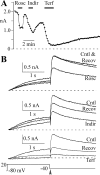
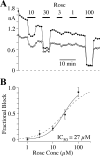

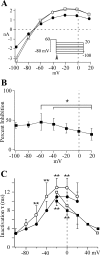
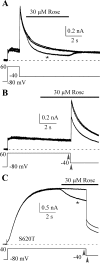

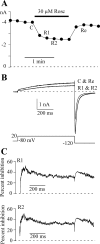


Similar articles
-
The molecular determinants of R-roscovitine block of hERG channels.PLoS One. 2019 Sep 3;14(9):e0217733. doi: 10.1371/journal.pone.0217733. eCollection 2019. PLoS One. 2019. PMID: 31479461 Free PMC article.
-
Molecular determinants of cocaine block of human ether-á-go-go-related gene potassium channels.J Pharmacol Exp Ther. 2006 May;317(2):865-74. doi: 10.1124/jpet.105.098103. Epub 2006 Jan 5. J Pharmacol Exp Ther. 2006. PMID: 16397089
-
Inhibition of the HERG channel by droperidol depends on channel gating and involves the S6 residue F656.Anesth Analg. 2008 Apr;106(4):1161-70, table of contents. doi: 10.1213/ane.0b013e3181684974. Anesth Analg. 2008. Retraction in: Anesth Analg. 2008 Sep;107(3):1040. doi: 10.1213/ane.0b013e31817e7b40. PMID: 18349188 Retracted.
-
The cardiac hERG/IKr potassium channel as pharmacological target: structure, function, regulation, and clinical applications.Curr Pharm Des. 2006;12(18):2271-83. doi: 10.2174/138161206777585102. Curr Pharm Des. 2006. PMID: 16787254 Review.
-
[HERG K+ channel, the target of anti-arrhythmias drugs].Yao Xue Xue Bao. 2007 Jul;42(7):687-91. Yao Xue Xue Bao. 2007. PMID: 17882949 Review. Chinese.
Cited by
-
Imatinib mesylate decreases the cytotoxic effect of roscovitine on human glioblastoma cells in vitro and the role of midkine.Oncol Lett. 2012 Jan;3(1):200-208. doi: 10.3892/ol.2011.434. Epub 2011 Oct 4. Oncol Lett. 2012. PMID: 22740881 Free PMC article.
-
Roscovitine inhibits CaV3.1 (T-type) channels by preferentially affecting closed-state inactivation.J Pharmacol Exp Ther. 2012 Feb;340(2):463-72. doi: 10.1124/jpet.111.187104. Epub 2011 Nov 16. J Pharmacol Exp Ther. 2012. PMID: 22088954 Free PMC article.
-
Voltage-gated ion channels in cancer cell proliferation.Cancers (Basel). 2015 May 22;7(2):849-75. doi: 10.3390/cancers7020813. Cancers (Basel). 2015. PMID: 26010603 Free PMC article. Review.
-
Suppression of ventricular arrhythmias by targeting late L-type Ca2+ current.J Gen Physiol. 2021 Dec 6;153(12):e202012584. doi: 10.1085/jgp.202012584. Epub 2021 Oct 26. J Gen Physiol. 2021. PMID: 34698805 Free PMC article.
-
Acepromazine inhibits hERG potassium ion channels expressed in human embryonic kidney 293 cells.Korean J Physiol Pharmacol. 2017 Jan;21(1):75-82. doi: 10.4196/kjpp.2017.21.1.75. Epub 2016 Dec 21. Korean J Physiol Pharmacol. 2017. PMID: 28066143 Free PMC article.
References
-
- Arcangeli A Expression and role of hERG channels in cancer cells. Novartis Found Symp 266: 225–232; discussion 232–224, 2005. - PubMed
-
- Benson C, White J, De Bono J, O'Donnell A, Raynaud F, Cruickshank C, McGrath H, Walton M, Workman P, Kaye S, Cassidy J, Gianella-Borradori A, Judson I, Twelves C. A phase I trial of the selective oral cyclin-dependent kinase inhibitor seliciclib (CYC202; R-roscovitine), administered twice daily for 7 days every 21 days. Br J Cancer 96: 29–37, 2007. - PMC - PubMed
-
- Bril A, Gout B, Bonhomme M, Landais L, Faivre JF, Linee P, Poyser RH, Ruffolo RR Jr. Combined potassium and calcium channel blocking activities as a basis for antiarrhythmic efficacy with low proarrhythmic risk: experimental profile of BRL-32872. J Pharmacol Exp Ther 276: 637–646, 1996. - PubMed
Publication types
MeSH terms
Substances
Grants and funding
LinkOut - more resources
Full Text Sources

